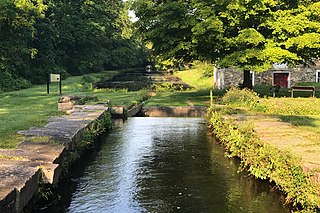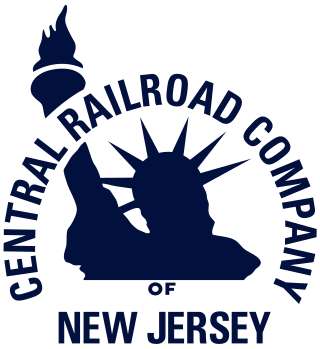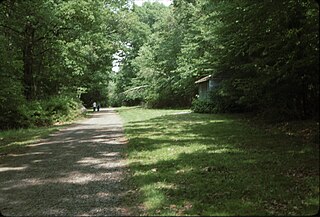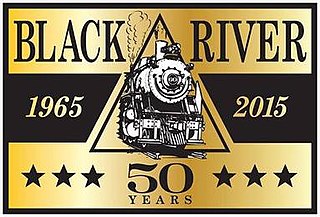The Hibernia Mine Railroad was a mine railroad in Morris County, New Jersey that operated between Hibernia and Rockaway from 1863 to 1946.
The Hibernia Mine Railroad was a mine railroad in Morris County, New Jersey that operated between Hibernia and Rockaway from 1863 to 1946.

The railroad was incorporated in 1863 by various owners of the Hibernia iron mines. It was authorized to transport ore from the mines to the Morris Canal, with the possibility of extension south to the Morris and Essex Railroad. That extension was built in 1868, and the charter was modified to allow the use of steam power along the length of the line, which previously had been limited to animal power between the mines and the canal.
In 1881 the completion of the Dover and Rockaway Railroad established a connection between the Hibernia Mine RR and the Central Railroad of New Jersey (CNJ) at Port Oram (modern day Wharton). The line operated profitably on its ore business, making it an attractive acquisition for the CNJ, which leased it in 1890 and incorporated it into the High Bridge Branch line.
Production at the Hibernia Mines rapidly declined during the 1890s and by 1907 only one shaft was producing. The Hibernia mines were finally closed in 1916, and although the Beach Glen mines reopened briefly in the 1920s, all the mines were closed in 1930. Although the ore traffic ceased, several industrial customers in Rockaway remained, and in 1930 the CNJ eliminated the expenses of its lease by purchasing the line outright, eventually abandoning the northern portion of the line in 1946. The segment that serviced Rockaway's industrial customers remains in operation and is operated today by the Morristown and Erie railroad.

The Morris Canal (1829–1924) was a 107-mile (172 km) common carrier anthracite coal canal across northern New Jersey that connected the two industrial canals in Easton, Pennsylvania across the Delaware River from its western terminus at Phillipsburg, New Jersey to New York Harbor and New York City through its eastern terminals in Newark and on the Hudson River in Jersey City. The canal was sometimes called the Morris and Essex Canal, in error, due to confusion with the nearby and unrelated Morris and Essex Railroad.

The Delaware, Lackawanna and Western Railroad, also known as the DL&W or Lackawanna Railroad, was a U.S. Class 1 railroad that connected Buffalo, New York, and Hoboken, New Jersey, and by ferry with New York City, a distance of 395 miles (636 km). The railroad was incorporated in Pennsylvania in 1853, and created primarily to provide a means of transport of anthracite coal from the Coal Region in Northeast Pennsylvania to large coal markets in New York City. The railroad gradually expanded both east and west, and eventually linked Buffalo with New York City.
The Lehigh Valley Railroad was a railroad in the Northeastern United States built predominantly to haul anthracite coal from the Coal Region in Northeastern Pennsylvania to major consumer markets in Philadelphia, New York City, and elsewhere.

The Central Railroad of New Jersey, also known as the Jersey Central, Jersey Central Lines or New Jersey Central, was a Class I railroad with origins in the 1830s. It was absorbed into Conrail in April 1976 along with several other prominent bankrupt railroads of the Northeastern United States.
The United New Jersey Railroad and Canal Company (UNJ&CC) was a United States–based railroad company established in 1872. It was formed by the consolidation of three existing companies: the Camden and Amboy Railroad, Delaware and Raritan Canal Company, and New Jersey Rail Road and Transportation Company. The Camden and Amboy and New Jersey Rail Road were among the earliest North American railroads. The Pennsylvania Railroad leased the United New Jersey Railroad and Canal Company in 1872.
The New York and Long Branch Railroad was a railroad in central New Jersey, running from Bay Head Junction in Bay Head to Perth Amboy, where it connected to the Central Railroad of New Jersey's Perth Amboy and Elizabethport Railroad. The railroad was jointly owned and operated by the Pennsylvania Railroad and the Central Railroad of New Jersey and became property of Conrail in 1976. It is now part of New Jersey Transit's North Jersey Coast Line.
The Dover and Rockaway Railroad was a section of railroad track completed in 1881 connecting Dover, NJ and Rockaway, New Jersey. It formed an important link in the developing U.S. railroad system, connecting major trunks to the New York harbor for freight and provided passenger service to central and southern New Jersey.

The Delaware and Hudson Railway (D&H) is a railroad that operates in the Northeastern United States. In 1991, after more than 150 years as an independent railroad, the D&H was purchased by the Canadian Pacific Railway (CP). CP, which would itself become part of Canadian Pacific Kansas City in 2023, operated D&H under its subsidiary Soo Line Corporation, which also operates Soo Line Railroad.
The Belvidere-Delaware Railroad was a railroad running along the eastern shore of the Delaware River from Trenton, New Jersey north via Phillipsburg, New Jersey to Manunka Chunk, New Jersey. It became an important feeder line for the Lehigh Valley Railroad's join to the Central Railroad of New Jersey, which was constructed into Phillipsburg, New Jersey, at about the same time. This connected Philadelphia and Trenton, New Jersey at one end of the shortline railroad to the rapidly growing lower Wyoming Valley region, and via the Morris Canal or the CNJ, a slow or fast connection to New York City ferries crossing New York Harbor from Jersey City, New Jersey.

The Rahway Valley Railroad (RV) was a shortline railroad in the Northeastern United States. During their operations, the RV was considered as one of the most successful shortline railroads in U.S. history. The RV interchanged with the Lehigh Valley Railroad (LV) in Roselle Park, the Central Railroad of New Jersey (CNJ) in Cranford, and the Delaware, Lackawanna and Western Railroad (DL&W) in Summit.

The High Bridge Branch is a branch line that was operated by the Central Railroad of New Jersey (CNJ). As built, the branch started in High Bridge, New Jersey at a connection with the CNJ main line and continued north to iron-ore mines in Morris County. The High Bridge Branch line followed the South Branch of the Raritan River for much of its duration.
The Hibernia mines are a series of iron mines in and around Rockaway Township, in Morris County, New Jersey, United States, that were worked from pre-Revolutionary times until 1916. The mines worked a vein extending for more than two miles (3.2 km). Several companies operated mines in the area. An adit was constructed into the Hibernia hill to move ore to the railhead of the Hibernia Railroad. Ore in excess of 90,000 short tons (82,000 t) was shipped in 1879.

The Rockaway Valley Railroad, also known as the New Jersey and Pennsylvania Railroad and informally known as the Rock-A-Bye Baby, was an American short line. Built from a connection with the Central Railroad of New Jersey (CNJ) mainline in White House Station, New Jersey, the railroad traveled north to Watnong, New Jersey, a total distance of approximately 25 miles. The railroad was constructed between 1888 and 1892, predominantly to ship peaches from orchards that were abundant along the southern part of the line, but it also carried passengers and other freight along the entire route. The Rockaway Valley Railroad (RVRR) ceased operation in 1914 and was abandoned in 1917. Much of the old railbed is now part of a rail-trail.

The Ogden Mine Railroad was a mine railroad in the U.S. state of New Jersey from 1866 until 1941.
The Sussex Railroad was a short-line railroad in northwestern New Jersey. It replaced its predecessor, the Sussex Mine Railroad, in 1853 and operated under the Sussex Railroad Company until 1945 when it was fully merged into the Delaware, Lackawanna and Western Railroad (DL&W) system. The Sussex Railroad was important in the economic development of Sussex County as it supplied a route for early local industries, such as dairy farms and ore mines, to export their products. It was the last independently operated New Jersey railroad to be incorporated into the DL&W system. The last train travelled on the Sussex Railroad tracks on October 2, 1966. The tracks were removed soon after and the right-of-way was transformed into a rail trail known as the Sussex Branch Trail.

The Black River and Western Railroad is a freight and heritage railroad operating in Hunterdon County, New Jersey, between Flemington, Lambertville and Ringoes. The railroad operates vintage steam and diesel powered locomotives.

Morristown & Erie Railway is a short-line railroad based in Morristown, New Jersey, chartered in 1895 as the Whippany River Railroad. It operates freight rail service in Morris County, New Jersey and surrounding areas on the original Whippany Line between Morristown and Roseland, as well as the Morris County-owned Dover & Rockaway Branch, Chester Branch, and High Bridge Branch. The M&E also operated the Maine Eastern Railroad from November 2003 to December 31, 2015.

The Lehigh Line is a railroad line in Central New Jersey, Northeastern Pennsylvania, and the Lehigh Valley region of eastern Pennsylvania. It is owned and operated by the Norfolk Southern Railway. The line runs west from the vicinity of the Port of New York and New Jersey in Manville, New Jersey via Conrail's Lehigh Line to the southern end of Wyoming Valley's Coal Region in Lehigh Township, Pennsylvania.
The Dover & Rockaway River Railroad is a short-line railroad operating in Morris County, New Jersey. On July 1, 2017, it took over operation of three Morris County owned rail lines previously operated by Morristown and Erie. The DRRV is a wholly owned subsidiary of Chesapeake and Delaware, LLC.